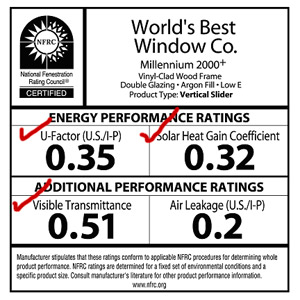10.2: Factors in Window Selection (I)
- Page ID
- 47213
The National Fenestration Rating Council (NFRC) developed an energy performance label, shown in Figure 10.2.1, that helps to determine how well a window performs the functions of helping to cool a building in the summer, warm a building in the winter, keep out wind, and resist condensation.

Figure 10.2.1. NFRC's window label
By using the information contained on the label, builders and consumers can reliably compare one product with another, and make informed decisions about the windows, doors, and skylights they buy. NFRC adopted a new energy performance label in 1998. It lists the manufacturer, describes the product, provides a source for additional information, and includes ratings for one or more energy performance characteristics.
NFRC rates all products in two standard sizes so that consumers and others can be sure they are comparing products of the same size. There are three factors that will be listed on the label with some additional information. These factors are U factor, Visible Transmittance (VT) and Solar Heat Gain Coefficient (SHGC).
U-Factor or Value
U-factor measures how well a product prevents heat from escaping. The rate of heat loss is indicated in terms of the U-factor (U-value) of a window assembly.
- U-Factor ratings generally fall between 0.20 and 1.20.
- The ratings are based on an outdoor temperature of 0oF (-18oC) and an indoor temperature of 70oF (21oC)
- Most window manufacturers label their windows with a U-value (conductance of heat, Btu/h °F ft 2).
U-values are the reciprocals of R-values (h °F ft 2/Btu).
- The lower the U-value, the less heat is lost through the window.
- The lower the U-value, the greater a window's resistance to heat flow and the better its insulating value, which is indicated by the R-value.
Thus, the U-value is the inverse of the R-value or:
\[ U = \dfrac{1}{R} \]
Some manufacturers rate thermal performance using R-Value. For example, an R-factor of 4.0 is the same as a U-Factor of 0.25.
The overall, "total," or "whole window" U-Factor of any window depends on the type of glazing, frame materials and size, glazing coatings, and type of gas (air, or inert argon or krypton) between the panes. Some typical U-, and R- Factor ranges for different window assemblies are shown in Table 10.2.1.
Table 10.2.1. U- and R-factor ranges
| Window assembly | U-factor | R-factor |
|---|---|---|
| Single glazed | 0.91 to 1.11 | 1.1 to 0.9 |
| Double glazed | 0.43 to 0.57 | 2.3 to 1.7 |
| Triple glazed | 0.15 to 0.33 | 6.7 to 3.3 |


